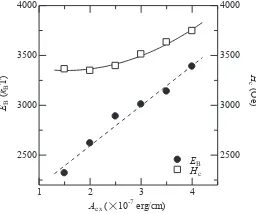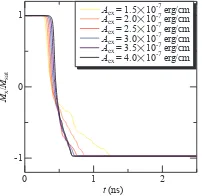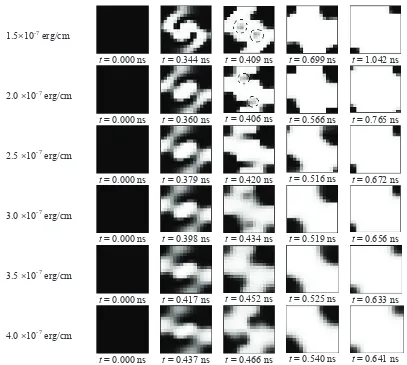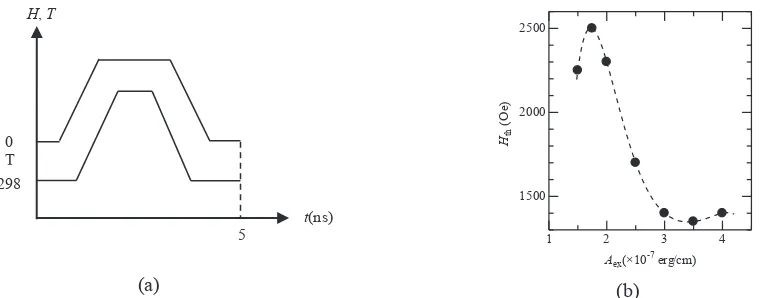Micromagnetic study of exchange interaction effect on magnetization reversal mode of
CoFeAl
Umi Muflihatun Nurul Azizah, Suryasatriya Trihandaru, and Nur Aji Wibowo
Citation: AIP Conference Proceedings 1710, 030014 (2016); doi: 10.1063/1.4941480 View online: http://dx.doi.org/10.1063/1.4941480
View Table of Contents: http://scitation.aip.org/content/aip/proceeding/aipcp/1710?ver=pdfcov Published by the AIP Publishing
Articles you may be interested in
Micromagnetic study of magnetization reversal and dipolar interactions in NiFe nano disks AIP Conf. Proc. 1512, 420 (2013); 10.1063/1.4791090
Local formation of a Heusler structure in CoFe–Al alloys Appl. Phys. Lett. 98, 012506 (2011); 10.1063/1.3517490
Erratum: "Magnetotransport properties and spin-torque effects in current perpendicular to the plane spine valves with Co–Fe–Al magnetic layers” [J. Appl. Phys.101, 093905 (2007)]
J. Appl. Phys. 102, 049902 (2007); 10.1063/1.2777128
Magnetotransport properties and spin-torque effects in current perpendicular to the plane spin valves with Co–Fe–Al magnetic layers
J. Appl. Phys. 101, 093905 (2007); 10.1063/1.2717012
Micromagnetic modeling of magnetization reversal of Fe/Cr/Co exchange coupled multilayers (abstract) J. Appl. Phys. 81, 3767 (1997); 10.1063/1.365502
Micromagnetic Study of Exchange Interaction Effect on
Magnetization Reversal Mode of CoFeAl
Umi Muflihatun Nurul Azizah
1,c), Suryasatriya Trihandaru
2, b)and Nur Aji
Wibowo
2, a)1 Department of Physics Education, Faculty of Science and Mathematics, Satya Wacana Christian University,
Salatiga 50711, Central Java, Indonesia
2
Department of Physics, Faculty of Science and Mathematics, Satya Wacana Christian University, Salatiga 50711, Central Java, Indonesia
a)[email protected] b)[email protected] c)[email protected]
Abstract. A magnetization switching dynamics of perpendicular magnetic anisotropy material CoFeAl has been simulated. This simulation was conducted using Landau-Lifshift Gilbert equation. The used magnetic parameters are magnetic anisotropy 2.3 × 106 erg/cm3, magnetic saturation 10 kG, medium Gilbert damping 0.3 and various exchange constants in a range of (1.5 – 4.0) × 10-7 erg/cm. CoFeAl is modeled as a parallel-pipe with the dimension is 50×50×20 nm3. As a result, this simulation predicts that the chosen materials exhibit good thermal stability which is greatly affected by exchange energy. Magnetization reversal mechanism is dominated by domain wall propagation process. Moreover, the simultaneous distribution of thermal with external magnetic field on the materials reduces the writing field which reaches the minimum value when exchange constant is 3.5 × 10-7 erg/cm.
INTRODUCTION
In this research, micromagnetic simulation method is used to observe the behaviors of nano-dot magnetization in micro scale [2]. What is researched in this study is the effect of magnetic parameter, which is exchange constant of CoFeAl towards magnetization reversal process of magnetic-based storage material. Exchange constant is important to study because it is closely related to interaction between the adjacent spins in the media [8] which affects the behaviors of nano-dot magnetization reversal. Behaviors of magnetization reversal have to be researched to understand the potential of materials to be applied in magnetic-based storage media [2].
METHOD
The total energy of a micromagnetic system is known as the Gibbs free energy, Etot, which is affected by
magnetization polarization, external field, and a number of magnetic parameters. Etotincludes Zeeman energy,
magneto static energy, magnetocrystal energy, and exchange energy. Etotis formulated in Equation (1)[9].
2 2 2 2 11
2
tot x y z ext magn
E A KA . . . dV
:
§ § · ·
³¨© ¨© m m m ¸¹ a m J H J H ¸¹
(1)
Where
0Ms . ,t , 1
P
J r m r m
(2)
In this equation, m is magnetic moment of cell unit
m M Mswith M is the magnetization and Ms is themagnetic saturation, mx,y ,zis the space gradient of magnetic moment components which are normalized towards
x, y, and z axis, KAis anisotropy constant, a is vector unit parallel to easy axis, J is magnetic polarization which is shown by Equation (2) where P0is vacuum permeability, Hextis external magnetic field, Hmagnis magnetostatic
field, and A is the function of exchange constant shown by equation A JS c d2 , where J is the sum of exchange,
S2 is square of the spin, d is the distance between the nearest spins, and c is crystal structure [9].
In equilibrium-magnetized state, magnetic moments of cell units are in line with the direction of effective magnetization fieldHeff . The function of Heffis shown in Equation (3) [9].
2 2
eff ext magn
s s K A . M M A '
H m a m a H H
(3)
WhereMsis magnetic saturation, and the function of 'mis shown in Equation (4)[10].
2 2 2
2 x 2 y 2 z
x y z
w w w
'
w w w
m m m m
(4)
magn
H is calculated using Equation (5)[9].
magn U
H
(5)
WhereU is scalar magnetic potential calculated using Equation (6).
0 in s out U M U ' ' m
(6)
Where
Uinand
Uoutare scalar magnetic potentials inside and outside nano-dot with limitations as stated in
Equation. (7)[9].
in out in out s U U U U M . w wwn wn m n
(7)
Before the magnetic moment reach the equilibrium state, it will evolves according to Equation (8) which is known as Landau-Lifshiftz-Gilbert equation [8][11].
[ ]
eff Ts
d
d
γ
dt
M
dt
D
u
u
m
m H
H
m
m
(8)
030014-2
Withα is Gilbert damping constant, and γ is gyromagnetic ratio (1.76×107 oe-1.s-1) and T
H is stochastic thermal field.
Equation (8) is solved numerically using magnetic parameters, which are exchange constant Aex, anisotropy
constant KA, and magnetic saturation Ms which depends on the temperature, as shown in Equation (9), (10) and (11)
[12].
2 0
0 s ex
s M T
A T A
M
§ ·
¨ ¸
¨ ¸
© ¹
(9)
2 0
0 s s
M T
K T K
M
A A
§ ·
¨ ¸
¨ ¸
© ¹
(10)
0 50 1 .
s s c
M T M T / T
(11)
Where T is operation temperature and Tc is Curie temperature (1000 K).
After m is calculated using Equation 8, the total energy, Etotcan be calculated. Because m evolves towards time,
then Etotalso changes towards time. In the time interval given, Etotwill reach its maximum value
Emaxandminimum value
Emin. When it reachesEmax, Hextis equal toHc.Eminis calculated before and after the magneticmoments reversal process. In particular temperature T andHext, the difference between EmaxandEmin can be
calculated. The difference is called barrier energy EB for magnetic moments reversal. Its magnitude is calculated
using Equation (12).
B max min
E E E
(12)
The total of temperature fluctuation field is assumed to follow Gaussian distribution with amplitude calculated using fluctuation-dissipation theorem as shown in Equation (13 – 14) [3][11].
( )
0
i T
H t
(13)
B
s
2k T
α
σ
=
γ
VM
Δ
t
(14)
Where kB = Boltzman constant, V = nano-dot volume, and 't = time difference (0.25×10-12s).
The perpendicular anisotropy material used as a model in this research is CoFeAl with magnetic parameters KA=
2.3 × 106 erg/cm3, 4SM
s = 10 kG, α = 0.3, and Aex = (1.5 – 4.0) × 10-7 erg/cm. CoFeAl is modeled in the form of
block with a size of 50×50 nm2 and width of 20 nm called nano-dot or a one-bit information storage. The nano-dot
consists of 15u15 cell units. Each of them has dimension of 3.3u3.3u20 nm3 and represents one direction of
magnetic moments m. The size is chosen to realize HDD with density of ~250 Gbit/inch2. This CoFeAl model is
shown in Fig. 1.
FIGURE 1. Model of nano-CoFeAl with volume of 50u50u20 nm3 consisting of 15u15 cell units.
y
z
x
w
l
RESULT AND DISCUSSION
FIGURE 2. Scheme of micromagnetic simulation of Nano-CoFeAl in room temperature.
Nano-CoFeAl which is evaluated numerically in this research has in-line magnetization directions with +x axis. Then, it is given with external magnetic field in the direction of –x which magnitude increases linearly from 0 to 20
kOe in room temperature (298 K) for 2.5 ns as shown in Fig. 2. An important thing to research in the magnetization reversal mechanism of nano-CoFeAl is the existence of barrier energy which separates two stable conditions of magnetization, which are initial condition and magnetized condition. Initial condition is a condition where the magnetization direction of nano-CoFeAl is opposite to the direction of external magnetic field. Meanwhile, magnetized condition is a condition where the magnetization direction of nano-CoFeAl is already in line to the given external magnetic field. The existence of the barrier energy shows that energy is required to reverse the magnetization direction of nano-CoFeAl from its initial equilibrium state into its second equilibrium state.
FIGURE 3. Energy profile which has to be overcome in the magnetization reversal of nano-CoFeAl for variations of material intrinsicproperty, which is exchange constant (Aex) =
(1.5 – 4.0) × 10-7 erg/cm in room temperature
HT 0.FIGURE 4. Barrier energy and coercive field change in magnetization reversal of nano-CoFeAl towards the increase of
exchange constant (Aex) = (1.5 – 4.0) × 10-7 erg/cm in room temperature.
Figure 3 shows the energy barrier (EB) profile of nano-CoFeAl for six variations of exchange constant values
(Aex) during the external magnetic field induction,Hext. It is shown that the higher the Aex value (the higher the EB)
has to be overcome. It is known that Aex contributes to the magnitude of exchange energy which further affects the
magnitude of EB. Exchange energy will decrease if the direction of the nearest magnetic moments in the material is
parallel [9]. For a number of Aex values which have been researched, it is observed that the peak of EB can be
reached at the same time. The peak of EB is a condition in which the magnetization direction of nano-CoFeAl will
exactly reverse. This shows that exchange constant tends to have less effect on the time required for magnetization reversal. It is also observed that Aex affects the width of barrier energy 'G where the constriction of 'G takes
place along with the increase of Aex.
The manipulation of material characteristics using a number of Aex variations affects the magnitude of EB and
coercive field (Hc), as shown in Fig. 4. The magnitude of EB can be found by calculating the difference between the
peak energy and the base energy formed during external field induction, as shown in Fig. 2. If EB is quite small, the
0 1 2
2000 3000 4000 5000 6000
E
(
kB
T)
t (ns)
Aex = 1.5Ć10-7 erg/cm
Aex = 2.0Ć10-7 erg/cm
Aex = 2.5Ć10-7 erg/cm
Aex = 3.0Ć10-7 erg/cm
Aex = 3.5Ć10-7 erg/cm
Aex = 4.0Ć10-7 erg/cm
EB
ċģ
1 2 3 4
2500 3000 3500 4000
2500 3000 3500 4000
EB
(
kB
T)
Aex (Ć10-7 erg/cm)
H
c (O
e)
EB
Hc 298
2.5 t (ns) 2.5 t (ns)
20
Hext (kOe)
T (K)
030014-4
media magnetization becomes unstable for a long time. The EB value required for HDD media to have good thermal
stability and survival rate over than 10 years is ≥ 60 kBT [6][8]. The result shows that EB for all exchange constant
values are over 60 kBT. Therefore, it is known that CoFeAl with composition of those material intrinsic properties
can also be used as HDD media with good thermal stability for over 10 years. It is also shown that EB tends to get
stronger along with the increase of Aex. It is related to the effect of crystal structure towards the magnitude of
exchange interaction. A media with high exchange interaction will have high c value. With high c value, crystal structure will have a tendency towards particular directions. Because crystal structure tends to align to particular directions along with the increase of Aex, the magnetization direction of CoFeAl will be more difficult to reverse and
have high EB value. In addition to barrier energy, Hc, which is required in magnetization reversal of nano-CoFeAl, is
also getting higher along with the increase of exchange interaction, where Hc is the required field to reverse the
direction of media magnetizations up to 50% [10]. The interesting part is the difference in the increasing patterns of EB and Hc. It is observed that EB tends to increase linearly along with the increase of Aex, whereas Hc is not having
same phenomenon.
FIGURE 5. The magnitude difference of nucleation field in magnetization reversal of nano-CoFeAl for exchange constant
(Aex) = (1.5 – 4.0) × 10-7 erg/cm in room temperature
HT 0.FIGURE 6. Magnetization reversal curve of nano-CoFeAl for variations of the material intrinsic property, which is exchange constant (Aex) = (1.5 – 4.0) × 10-7 erg/cm in room temperature.
Figure 5 shows the exchange constant dependence of nucleation field (Hn). Hn is the required field to force
magnetization directions of the material reverse from its initial conditions [13]. When Aex< 3× 10-7 erg/cm, Hn
decreases significantly for a small change of Aex. However, when Aex> 3.0 × 10-7 erg/cm, Hn tends to be stable
towards Aex increase. The interesting part is when EB and Hcare getting stronger along with the increase of exchange
constant, as shown in Fig. 4. However, nucleation field is getting smaller along with the increase of Aex. This is
caused by the constriction of 'G for stronger exchange interaction.
Figure 6 shows the magnetization reversal curve of nano-CoFeAl for the various exchange constants during the external field induction, Hext. The initial direction of nano-dot magnetizations (t = 0 ns) before the field induction
is in line with +x axis. The external field is submitted in the direction of –x axis and increased from 0 – 2 T for 2.5
ns. This magnetization dynamics is represented by the value of M/Msat. M is instantaneous magnetization direction in
the direction of x axis and Msat is the initial magnetization direction of nano-CoFeAl. If the value of M/Msat is 1, it
shows that M and Msat has the same magnitude and magnetization direction. If the value of M/Msat is 0, it shows that
the total magnetization of M and Msat is zero. In that condition, magnetization of nano-CoFeAl will exactly reverse
and become parallel toHext. On the other hand, if the value of M/Msat is -1, it shows the magnetized condition,
which is the condition when M and Msat has the same magnitude of magnetization with opposite direction, or the
condition where material magnetizations are already in line withHext. During the field induction, the direction of
media magnetization changes along with time until magnetization directions are in line withHext. Through media
inducing process withHext, magnetization direction of nano-CoFeAl can be reversed. It is shown that media with
high Aex requires faster time for the reversal of its magnetization directions compared to media with low Aex. For all
values of simulated Aex, magnetization reversal curve tends to form the S shape. This curve pattern shows that
magnetization reversal process of nano-CoFeAl is more dominated by domain wall propagation process than domain wall nucleation. Moreover, it is shown that when Aex is 1.5 × 10-7 erg/cm and 2.0 × 10-7 erg/cm, magnetization
dissipation occurs, so that the reversal process is slowed. This happens because exchange energy decreases, whereas
2 3 4
6000 7000 8000 9000 10000
Aex (Ć10-7 erg/cm)
Hn
(O
e)
0 1 2
-1 0
1 Aex = 1.5Ć10-7 erg/cm
Aex = 2.0Ć10-7 erg/cm
Aex = 2.5Ć10-7 erg/cm
Aex = 3.0Ć10-7 erg/cm
Aex = 3.5Ć10-7 erg/cm
Aex = 4.0Ć10-7 erg/cm
t (ns)
Mx
/
Msa
contributions from other energy increase. This result shows that by using the distributed field induction, nano-CoFeAl can be magnetized.
FIGURE 7. Micrograph of magnetization reversal mechanism of nano-CoFeAl with K┴ = 2.3 u 106 erg/cm3, D 0.3and
4SMs 10kG for variations of exchange constants (Aex) = (1.5 – 4.0) × 10-7 erg/cm in room temperature
HT 0Magnetization reversal modes from the simulated values of Aex have identical patterns as shown in Fig. 7. At
first, nano-dot consists of only one domain which magnetic moments are in line with +x axis. This domain is shown in black color. Along with the increase ofHext, white domain starts to form in the center of the nano-dot with a
pattern resembling Z letter. This domain has magnetic moments parallel toHext. Between the two domains, a grey
area, which acts as their boundaries, is formed. This area is known as domain wall. The domain wall propagates to all directions until the magnetization of nano-dot are parallel toHext. This magnetization is marked with the
nano-dot’s change of color from black to white. The forming of the white domain, which starts from the center, shows that
magnetic moments reversal easily occurs in the center compared to other regions. This is caused by the dominance of exchange interaction in the center of the nano-dot. With this domination, magnetic moments in the center of nano-CoFeAl will be less stable compared to magnetics moments in other sides. This instability causes magnetic moments in the center to reverse easier and faster compared to other sides.
1.5u10-7 erg/cm
t = 0.000 ns t = 0.344 ns t = 0.409 ns t = 0.699 ns t = 1.042 ns
2.0 u10-7 erg/cm
t = 0.000 ns t = 0.360 ns t = 0.406 ns t = 0.566 ns t = 0.765 ns
2.5 u10-7 erg/cm
t = 0.000 ns t = 0.379 ns t = 0.420 ns t = 0.516 ns t = 0.672 ns
3.0 u10-7 erg/cm
t = 0.000 ns t = 0.398 ns t = 0.434 ns t = 0.519 ns t = 0.656 ns
3.5 u10-7 erg/cm
t = 0.000 ns t = 0.417 ns t = 0.452 ns t = 0.525 ns t = 0.633 ns
4.0 u10-7 erg/cm
t = 0.000 ns t = 0.437 ns t = 0.466 ns t = 0.540 ns t = 0.641 ns
030014-6
(a) (b)
FIGURE 8. (a) Simulation scheme of magnetization reversal using writing field pulse and thermal pulse, (b) Dependence pattern of threshold field (Hth) in magnetization reversal of nano-CoFeAl for exchange constant (Aex) = (1.5 - 4.0) u10-7 erg/cm.
In the magnetization reversal scheme in room temperature – without thermal stimulation, reversal field required
for various simulated Aex reaches 5520 – 10000 Oe. This value is classified as too high to use in magnetic-based
recording technology. Therefore, in the second part of this paper, thermal field is also inducted simultaneously to magnetic field, as shown in Fig. 8 (a). Both fields increase linearly from 0 Tesla and 298 K for Hw and Tw
consecutively until it reaches particular magnitude, is constant at that value for a period of time, and then decreases linearly to reach its initial value. In this case, Tw increases near Curie temperature. All of this process is done in 5 ns
[1][6]. To evaluate the stochastic effect because of the temperature stimulant effect in magnetization process, this simulation is performed using 20 different random numbers [3]. Using thermal stimulation, there is thermal field (HT) which is also contributed to the magnitude of Heffin Equation (3).
Using this scheme, the required field to magnetizes the media or what is called as writing field can be determined by calculating the threshold field (Hth). Hth is the minimum magnetic field required until the reversal probability
from the 20 random numbers has a value of 1. The Aex dependence of Hth is shown in Fig. 8 (b). The required Hth for
various simulated Aex (1.5 – 4.0) u10-7 erg/cm is between 1350 – 2500 Oe. Fluctuation of Hth in the range of given
Aex is appropriate to sixth degree of polynomial function as shown in fitted dashed line. It can be seen that Hth tends
to stable for Aex ≥ 3.0 u10-7 erg/cm and has the highest magnitude, which is 2500 Oe, for Aex is 1.75 u10-7 erg/cm.
The result is lower than the reversal field required in a case without any thermal pulse stimulation.
CONCLUSION
Micromagnetic simulation study of nano-CoFeAl for magnetic recording media application using HAMR technology has been performed by solving Landau – Liftshitz Gilbert equation. It is found that with a variety of
exchange constants in a range of (1.5 - 4.0) u10-7 erg/cm, CoFeAl is able to be used as HDD media because it meets the thermal stability requirements of materials. The requirement is having enormous barrier energy in an interval of 2230 – 3390 kBT. This barrier energy magnitude affects the strength of material coercivity, which causes high
reversal field. The magnitude of reversal field can be overcome by stimulation of thermal field so it can be lowered from a range of 5520 – 10000 Oe into a range of 1350 – 2500 Oe. Magnetization reversal mode of nano-CoFeAl is
dominated by domain wall propagation process, which starts with domain forming from the center of nano-dot and propagates into all directions.
ACKNOWLEDGMENTS
This research is funded by Department of Education, Central Java Province, through University Facilitation Young Lecturer Research Program.
1 2 3 4
1500 2000 2500
Hth
(O
e)
Aex(×10-7 erg/cm) 5
0 T 298
H, T
REFERENCES
1. N. A. Wibowo, C. Cari, and B. Purnama, J. Technol. Sci. 22,57-58, (2011).
2. N. A. Ananda, F. S. Rondonuwu and N.A. Wibowo, Smart Science, 3, 16-20, (2015).
3. B. Purnama, M. Koga, Y. Nozaki and K. Matsuyama, J. of Magnetism and Magnetik Materials, 321, 1325-1330, (2009).
4. H. I. Yim, J. S. Park, J. Y. Hwang, S. B. Lee, and T. W. Kim, J. of the Korean Physical Society, 57, 1672-1674, (2010).
5. M. Belmeguenei, H. Tuzcuoglu, M. Gabor, T. Petrisor, C. Tiusan, D. Berling, F. Zighem, and S. M. Chérif, J. of Magnetism and Magnetik Materials, 373, 140-143, (2013).
6. N. A. Wibowo, F. S. Rondonuwu, and B. Purnama, J. of Magn,19,237–240, (2014).
7. K. Shiiki, and H. Motojima, Journal of Physics, 200, 1-4, (2010).
8. P. Krone, doctor rerumnaturalium, Technische Universität Chemnitz, (2011).
9. J. Fidler, R.W, Chantrell, T. Schrefl and M.A. Wongsam, Encyclopedia of Materials Science and Technology, 5642-5651, (2001). DOI: 10.1016/b0-08-043152-6/00984-0.
10. Y. Nakatani, Y. Uesaka, and N. Hayashi, Japanese J. of Appl. Phys, 28, 2485-2507, (1989). 11. T. Schrelf, J. Fidler, D. Suess, W. Scholz and V. Tsiantos, (Springer US, 2006). p.128-146.
12. Y. Nosaki, Y. Isowaki, A. Hashimoto, B. Purnama, and K. Matsuyama, J. of Magnetic Soc, 30, 574-577, (2006).
13. H. J. Richter and S. D. Harkness IV, MRS Bulletin, 31, 384-387, (2006).
030014-8




